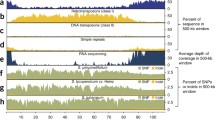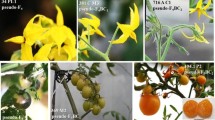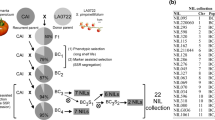Abstract
RFLP-defined chromosome segments covering the entire tomato genome were introgressed from the wild green-fruited speciesLycopersicon pennellii into the cultivated tomato (L. esculentum cv M82; Eshed et al. 1992). SixL. pennellii chromosome segments were selected for a detailed evaluation based on previous observations of their effects on the two yield components, fresh tomato yield and total soluble-solids content (Brix). Differences in the quantitative traits measured between M82 and the introgression lines, or their hybrids with different inbred parents, can be attributed to the alien chromosome segments. Replicated field trials, grown at wide and dense spacing, identified three quantitative trait loci (QTLs) for solublesolids content on chromosomes 1, 5 and 7. In plants heterozygous for the chromosome-5 locus there was a 50% increase in soluble-solids yield in wide but not in dense spacing. Plants heterozygous for the chromosome-1 QTL/s were tested over a 2-year period, in three genetic backgrounds, and showed a significant 16% elevation in soluble-solids yield only in dense spacing. These results demonstrate that wild tomato germplasm can be used to improve the yield of the cultivated crop.
Similar content being viewed by others
References
Bruce AB (1910) The Mendelian theory of heredity and the augmentation of vigor. Science 32: 627–628
Burr B, Burr FA (1991) Recombinant inbreds for molecular mapping in maize. Trends Genet 7: 55–60
De Vicente MC, Tanksley SD (1993) QTL analysis of transgressive segregation in an interspecific tomato cross. Genetics 134: 585–596
Diers BW, Keim P, Fehr WR, Shoemaker RC (1992) RFLP analysis of soybean seed protein and oil content. Theor Appl Genet 83: 608–612
East EM (1908) Inbreeding in corn. Rep Conn Agric Exp Stn 1907, pp 419–428
Edwards MD, Helentjaris T, Wright S, Stuber CW (1992) Molecular marker-facilitated investigations of quantitative trait loci in maize. 4. Analysis based on genome saturation with isozyme and restriction fragment length polymorphism markers. Theor Appl Genet 83: 765–774
Eshed Y, Abu-Abied M, Saranga Y, Zamir D (1992)Lycopersicon esculentum lines containing small overlapping introgressions fromL. pennellii. Theor Appl Genet 83: 1027–1034
Fatokun CA, Menancio-Hautea DI, Danesh D, Young ND (1992) Evidence for orthologous seed weight genes in cowpea and mung bean based on RFLP mapping. Genetics 132: 841–846
Goffreda JC, Mutschler MA (1989) Inheritance of potato aphid resistance in hybrids betweenLycopersicon esculentum andL. pennellii. Theor Appl Genet 78: 210–216
Keeble F, Pellew C (1910) The mode of inheritance of stature and flowering time in peas (Pisum sativum). J Genet 1: 47–56
Ladizinsky G (1985) Founder effect in crop-plant evolution. Econ Bot 39: 191–199
Levy AA, Braun D, Feldman M (1988) Evaluation of the effect of alien chromosomes on quantitative traits in common wheat. Genome 30: 265–268
Martin B, Nienhuis J, King G, Schaefer A (1989) Restriction fragment length polymorphism associated with water-use efficiency in tomato. Science 243: 1725–1728
Paterson AH, Lander ES, Hewitt JD, Peterson S, Lincoln SE, Tanksley SD (1988) Resolution of quantitative traits into Mendelian factors, using a complete linkage map of restriction fragment length polymorphisms. Nature 335: 721–726
Paterson AH, DeVerna JW, Lanini B, Tanksley SD (1990) Fine mapping of quantitative trait loci using selected overlapping recombinant chromosomes, in an interspecific cross of tomato. Genetics 124: 735–742
Paterson AH, Damon S, Hewitt JD, Zamir D, Rabinowitch HD, Lincoln SE, Lander ES, Tanksley SD (1991) Mendelian factors underlying quantitative traits in tomato: comparison across species, generations and environments. Genetics 127: 181–197
Rick CM (1982) The potential of exotic germplasm for tomato improvement. In: Vasil IK, Scowcroft WR, Frey KJ (eds) Plant improvement and somatic cell genetics. Academic Press, New York, pp 1–28
Saranga Y, Marani A, Zamir D, Rudich J (1991) Breeding tomatoes for salt tolerance. I. Field screening ofLycopersicon accessions for yield and dry matter production. J Am Soc Hort Sci 116: 1067–1071
Saranga Y, Cahaner A, Zamir D, Marani A, Rudich J (1992) Breeding tomatoes for salt tolerance. III. Inheritance of salt tolerance and related traits in interspecific populations. Theor Appl Genet 84: 390–396
Shull GH (1908) The composition of a field of maize. Rep Am Breed Assoc 4:296–301
Stevens MA, Rick CM (1986) Genetics and breeding. In: Atherton JG, Rudich J (eds) The tomato crop, a scientific basis for improvement. Chapman and Hall, New York, pp 35–109
Stevens MA, Rudich J (1978) Genetic potential for overcoming physiological limitations on adaptability, yield, and quality in the tomato. Hort Sci 13: 673–678
Stuber CW, Lincoln SE, Wolff DW, Helentjaris T, Lander ES (1992) Identification of genetic factors contributing to heterosis in a hybrid from two elite maize inbred lines using molecular markers. Genetics 132: 823–839
Tanksley SD, Ganal MW, Prince JC, de Vicente MC, Bonierabale MW, Broun P, Fulton TM, Giovanonni JJ, Grandillo S, Martin GB, Messeguer R, Miller JC, Miller L, Paterson AH, Pineda O, Roder MS, Wing RA, Wu W, Young ND (1992) High-density molecular linkage maps of the tomato and potato genomes: biological inferences and practical applications. Genetics 132: 1141–1160
Wehrhahn C, Allard W (1965) The detection and measurement of the effects of individual genes involved in the inheritance of a quantitative character in wheat. Genetics 51: 109–119
Author information
Authors and Affiliations
Additional information
Communicated by F. Salamini
Rights and permissions
About this article
Cite this article
Eshed, Y., Zamir, D. Introgressions fromLycopersicon pennellii can improve the soluble-solids yield of tomato hybrids. Theoret. Appl. Genetics 88, 891–897 (1994). https://doi.org/10.1007/BF01254002
Received:
Accepted:
Issue Date:
DOI: https://doi.org/10.1007/BF01254002




